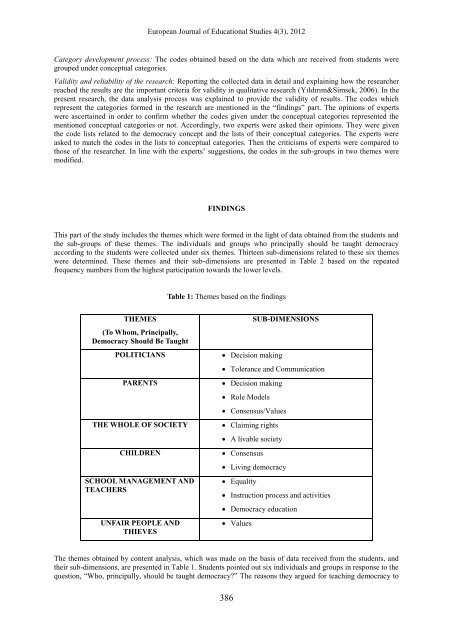Volume 4 Issue 3 (October 2012) - Ozean Publications
Volume 4 Issue 3 (October 2012) - Ozean Publications
Volume 4 Issue 3 (October 2012) - Ozean Publications
You also want an ePaper? Increase the reach of your titles
YUMPU automatically turns print PDFs into web optimized ePapers that Google loves.
European Journal of Educational Studies 4(3), <strong>2012</strong><br />
Category development process: The codes obtained based on the data which are received from students were<br />
grouped under conceptual categories.<br />
Validity and reliability of the research: Reporting the collected data in detail and explaining how the researcher<br />
reached the results are the important criteria for validity in qualitative research (Yıldırım&Simsek, 2006). In the<br />
present research, the data analysis process was explained to provide the validity of results. The codes which<br />
represent the categories formed in the research are mentioned in the “findings” part. The opinions of experts<br />
were ascertained in order to confirm whether the codes given under the conceptual categories represented the<br />
mentioned conceptual categories or not. Accordingly, two experts were asked their opinions. They were given<br />
the code lists related to the democracy concept and the lists of their conceptual categories. The experts were<br />
asked to match the codes in the lists to conceptual categories. Then the criticisms of experts were compared to<br />
those of the researcher. In line with the experts‟ suggestions, the codes in the sub-groups in two themes were<br />
modified.<br />
FINDINGS<br />
This part of the study includes the themes which were formed in the light of data obtained from the students and<br />
the sub-groups of these themes. The individuals and groups who principally should be taught democracy<br />
according to the students were collected under six themes. Thirteen sub-dimensions related to these six themes<br />
were determined. These themes and their sub-dimensions are presented in Table 2 based on the repeated<br />
frequency numbers from the highest participation towards the lower levels.<br />
Table 1: Themes based on the findings<br />
THEMES<br />
(To Whom, Principally,<br />
Democracy Should Be Taught<br />
POLITICIANS<br />
PARENTS<br />
THE WHOLE OF SOCIETY<br />
CHILDREN<br />
SCHOOL MANAGEMENT AND<br />
TEACHERS<br />
UNFAIR PEOPLE AND<br />
THIEVES<br />
SUB-DIMENSIONS<br />
Decision making<br />
Tolerance and Communication<br />
Decision making<br />
Role Models<br />
Consensus/Values<br />
Claiming rights<br />
A livable society<br />
Consensus<br />
Living democracy<br />
Equality<br />
Instruction process and activities<br />
Democracy education<br />
Values<br />
The themes obtained by content analysis, which was made on the basis of data received from the students, and<br />
their sub-dimensions, are presented in Table 1. Students pointed out six individuals and groups in response to the<br />
question, “Who, principally, should be taught democracy” The reasons they argued for teaching democracy to<br />
386

















